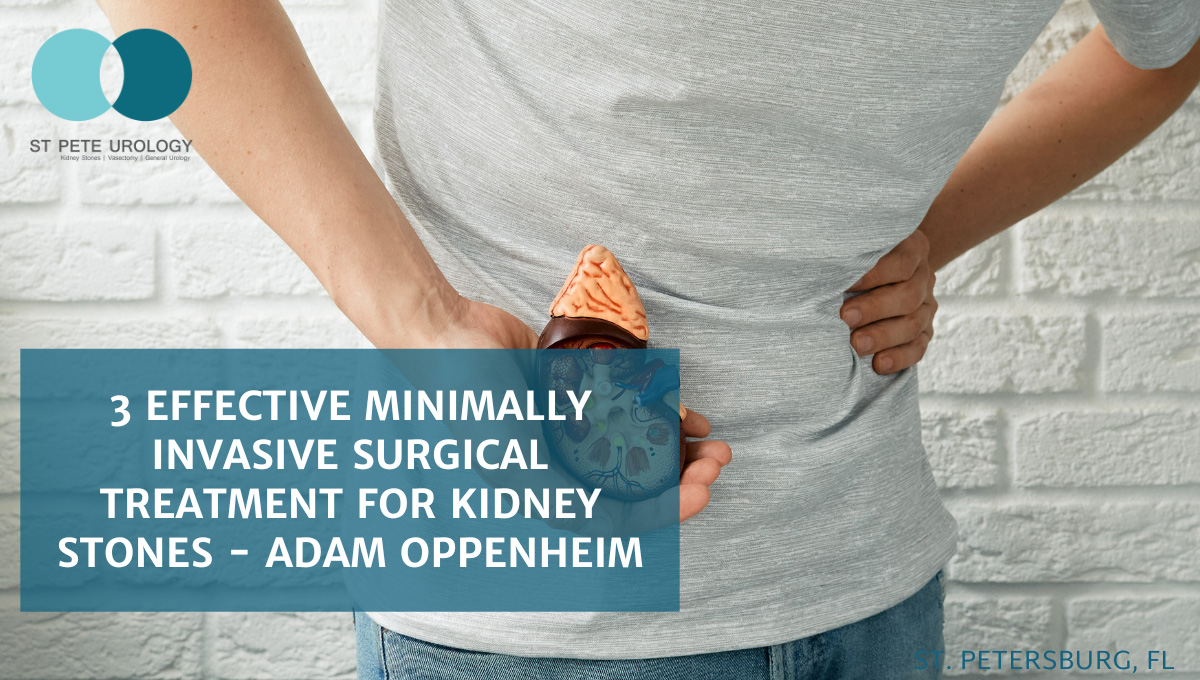3 Key Takeaways:
- There are three effective minimally invasive surgical treatment for kidney stones: Shockwave Lithotripsy, Ureteroscopy with Laser Lithotripsy, and Percutaneous Nephrolithotomy.
- Shockwave Lithotripsy is the least invasive procedure and is usually done in an outpatient setting with no incisions and minimal manipulation.
- The team at St. Pete Urology has the expertise and experience to provide personalized, state-of-the-art treatments for kidney stones.


The choice to move forward with any surgical procedure is one that is both personal and sometimes, necessary. Dr. Adam Oppenheim, a renowned urologist with St. Pete Urology in St. Petersburg, FL, spares no detail in discussing the three effective minimally invasive surgical treatments for kidney stones.
The Least Invasive Procedure: Shockwave Lithotripsy
The first procedure Dr. Oppenheim discusses is Shockwave Lithotripsy (SWL). Designed for those pesky little kidney stones, it is a simple and quite common procedure. No incisions and zero manipulation. “The shockwaves are administered from the machine from the outside when the patient is asleep,” Dr. Oppenheim explains. The cherry on top? It usually takes 20-30 minutes and the patient can go home soon afterwards. The only downside to this procedure is that it would not be effective in treating larger stones.
Ureteroscopy with Laser Lithotripsy: Mid-range Solution
Next, Dr. Oppenheim introduces us to Ureteroscopy with Laser Lithotripsy. This procedure is reserved for more mid-range sized stones or multiple stones in the kidney. “We use an endoscopic camera to go up into the kidney and visualize the inside of the kidney and actually use a laser to fragment stones or remove them using small baskets.” This procedure is also done in the outpatient setting, and the patient is sent home after the procedure. There may be brief discomfort from the temporary ureteral stent used, but it’s removed a few days later in the office.
Percutaneous Nephrolithotomy: For the Large Stones
Lastly, we have the Percutaneous Nephrolithotomy. This procedure is for the big leagues, the large stones. A larger size scope is used to go in through the patient’s back to fragment the large stones. “We have a radiologist help us obtain access to the kidney,” Dr. Oppenheim describes. This procedure carries some risk of bleeding and infection, therefore patients are admitted to the hospital for at least one night for monitoring.
Choosing the right surgical treatment for kidney stones
Choosing the surgical treatment for kidney stones is almost as critical as the surgery itself. Dr. Adam Oppenheim and the team at St. Pete Urology are a bevy of experienced urologists in St. Petersburg, FL. Their dedication to patient education and commitment to providing personalized, state-of-the-art treatments for kidney stones set them apart.
Making the decision to have kidney stone surgery is not easy, but thankfully, you do not need to make it alone. St Pete Urology is here to provide the guidance, expertise and care you need. Whether it’s Shockwave Lithotripsy, Ureteroscopy with Laser Lithotripsy, or Percutaneous Nephrolithotomy, the team at St Pete Urology has the experience and has your back, literally and figuratively. Let your fight against kidney stones be a fight you are sure to win.
References:
- “Kidney Stone Treatment: Shock Wave Lithotripsy.” https://www.kidney.org/atoz/content/kidneystones_shockwave.
- “Ureteroscopy with Laser Lithotripsy Treatment for Kidney Stones ….” https://www.dcurology.net/procedures/ureteroscopy-with-laser-lithotripsy.php.
- “Percutaneous Nephrolithotomy (PCNL) – Johns Hopkins Medicine.” https://www.hopkinsmedicine.org/health/treatment-tests-and-therapies/percutaneous-nephrolithonomy-pcnl.
Transcription:
I’m Dr. Adam Oppenheim, I’m a urologist with St. Pete Urology. So the least invasive procedure that we do is SWL or shockwave lithotripsy for the very small kidney stones. The benefits are that it’s a very simple procedure that we do quite commonly, no incisions or manipulation is done at all. The shockwaves are administered from the machine from the outside when the patient is asleep. It usually takes 20-30 minutes and the patient goes home soon afterwards. The drawbacks to this procedure are that it wouldn’t be effective in treating large stones.
The second one is called ureteroscopy with laser lithotripsy. This is for more middle range side stones or multiple stones in the kidney. This is when we use an endoscopic camera to go up into the kidney and visualize the inside of the kidney and actually use laser to fragment stones or remove them using small baskets. The recovery for that procedure, that’s also done in the outpatient setting. The patient is sent home after the procedure. We usually leave a ureteral stent, so the patient may have some symptoms from the ureteral stent briefly after the procedure, but then we take the stent out in the office a few days later.
Percutaneous nephrolithotomy, the patient comes in, this is an inpatient procedure. We use a larger size scope to go in through the patient’s back. We have a radiologist help us obtain access to the kidney, and we use a large scope and a special instrument to fragment the very large stones. This procedure is associated with some risk of bleeding and infection, and so the patient is admitted to the hospital for at least one night for monitoring.




